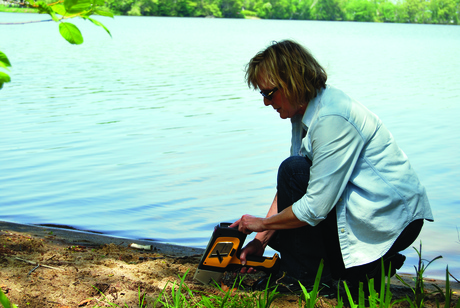Industrial contamination in Australia's backyards

Industrialisation has left much of the urban environment contaminated with a variety of heavy metals, chemicals and pesticide residues. Macquarie University researchers have produced a series of maps that plot the concentrations of metal pollutants across cities like Sydney and Darwin, and towns such as Mount Isa and Port Pirie.
Results of the survey indicate the spread of contamination in many ways reflected the growth of major cities, with the highest concentrations in older suburbs. The contaminant of most concern across Sydney backyards is lead. It would be expected that there would be contamination in a major city, explained the director of the Macquarie team, Professor Mark Taylor. “We live in an industrial environment. We have used lead-based petrol and paint for most of the 20th century.”
One technique for measuring levels of contaminant metals that is key to the work being conducted by the Macquarie team is X-ray fluorescence spectrometry (XRF). Simple screening for toxic metals is performed by placing an analyser directly onto soil or dust. The analyser provides detection of metals for site characterisation, contamination tracking, remediation monitoring and property evaluations.
The latest portable X-ray fluorescence (pXRF) analysers, such as the Delta Premium from Olympus, have been developed specifically for complete environmental investigations of metal contaminants in a wide range of industrial and domestic materials. The high-power, high-performance, rugged unit allows in situ analysis in a wide range of harsh environments from remote mining and exploration sites to backyards in major urban centres.
The latest model Delta unit offers increased speed and improved sensitivity. It also lowers the limit of detection (LOD) for challenging elements such as cadmium, barium, lead, mercury and tin.
According to Andrew Saliba, regional sales specialist with Olympus, the traditional use of pXRF has been for alloy identification, grading ore, mineral exploration, metallurgy and mine site remediation. “The technology has been refined and is now often used by environmental consultancies specialising in contaminated land remediation and recycling companies needing to determine what materials are in waste products,” he said.

Macquarie researcher Marek Rouillon has been working to evaluate the reliability and repeatability of XRF analysis on environmental samples. Professor Taylor and Rouillon regularly present their findings at seminars, outlining the spread of heavy metal contamination in suburban gardens in addition to explaining the application and relevance of the pXRF instrument for this project.
Typical ‘natural’ or ‘background’ concentrations of lead for the Sydney region are in the range 20–30 mg/kg or parts per million (ppm). However, due to the intense use of lead-containing products, much of Greater Sydney has been contaminated with the metal. Their results indicate Sydney residences have a mean soil lead concentration of 220 mg/kg, which is approximately 10 times the typical natural background for Sydney’s soils and rocks.
In 2012, the Centres for Disease Control and Prevention in the USA stated that there is no safe blood lead level for young children. Prior to this, health authorities around the world had issued guidelines for ‘acceptable’ levels of lead contamination, but surveys and reports have shown that even at the lowest levels there were health effects in children, including impaired brain development and behavioural disorders.
In conjunction with the contamination mapping, Macquarie researchers also run the community-orientated VegeSafe program. This is the largest study of its kind in the country and has provided information about metal contamination levels to more than 500 households across Sydney, and over 1000 households across Australia.

VegeSafe seeks to inform people about metals and metalloids in their garden soils and provides a free sampling program for domestic and community garden soils. Participants submit soil samples from private or community gardens and receive a formal report and links to information and advice about ‘what to do next’ if the soils contain elevated concentrations of metals and metalloids. “The VegeSafe motto is ‘Carry on Gardening’,” Professor Taylor said, “because this is exactly what we want people to do knowing that their soils are metal-free as is the produce from their gardens.”
According to Rouillon, the simplest mitigation technique for householders would be to cover the contaminated soil with either grass or mulch, to effectively reduce the potential generation of dust if the soil is dry and gets picked up by wind.
In contaminated suburbs where vegetables will be grown, the Macquarie team recommends growing produce in above-ground vegetable plots, using fresh clean topsoil. “Typically, undisturbed soil in urban areas accumulates contaminants over long periods of time and should be avoided when growing home produce,” Rouillon stated.
“Our recommendations are determined by different scenarios and contaminant concentrations,” Rouillon said. “VegeSafe provides specific recommendations and advice to a gardener for their particular situation.”
Other uses of pXRF analysis include extreme-weather debris migration studies, agriculture soil inspections, and construction and demolition waste sorting. A further use is as part of hazardous waste screening for disposal classification.
Originally published here.
Transforming pill packaging into fencing
The Vinyl Council of Australia is collaborating with several Australian industry partners to...
Eco nappies could release nutrients into the earth
Researchers are developing sustainable sanitary products made from food waste that can either be...
Why private investment is key to a plastic circular economy
To get to a future where plastic circularity is a scalable reality, significant investment needs...











